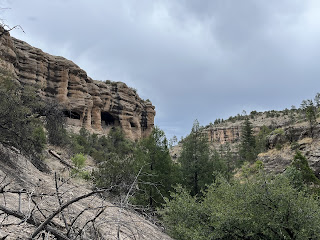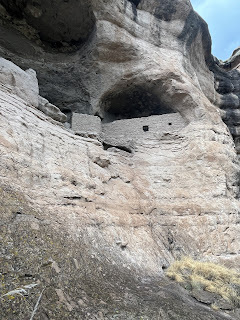Something I've learned over the years is that the longer you live somewhere, the less likely you are to go visit the more unique things around you. Whether it's feeling like you'll always have the opportunity or being jaded and not wanting to fight a bunch of tourists, the results are the same. Fewer Arizonans than you think have been to the Grand Canyon or Sedona or one of the tiny ghost towns hidden in the desert mountains; the same with Floridians and the Everglades or Alaskans and the Arctic Circle.
There are many historical indigenous sites that predate the U.S. scattered throughout the southwest. Some of the most famous are the cliff-dwellings. It's a little embarrassing, but despite living for over 10 years in Arizona, I had never been to one--so when I found out that there was a cliff-dwelling only a couple hours away from us I naturally piled the kids in the van and started driving. Four hours later found us winding carefully down steep hills in the Gila National Forest. The clouds had gathered during our drive and threatened rain, but after four hours in the van, we were going to finish the mission if it killed us. There was no turning back.
The Gila Cliff Dwellings are tucked away in a narrow canyon thick with oak and pine, accessible by a mile long track that snakes through the forest and up the side of a cliff. It is a series of 46 linked rooms built across five caves halfway up the cliff by the Mimbres Mogollon people in the late 1200s. The monument itself was designated in 1907 by President Theodore Roosevelt (a notable historian and naturalist responsible for many of our natural parks, among other things--he's a really interesting guy, look him up, there's an absolutely fascinating documentary on the interwebs called The Roosevelts).

The girls would have been satisfied just to play in the Gila River, but we herded them onto the trail. The track was rocky but not too steep, and even the climb up to the dwellings was a reasonable grade with enough switchbacks to keep those of us who aren't exactly in peak physical condition from dying. We saw a lizard, a deer, and numerous small birds. Since Rick and I are natural pedants, the girls were the grudging recipients of lectures on southwestern geology, erosion, trail medicine, and all the Mogollon facts we could find courtesy of Google. Thanks to the clouds, it was twenty degrees cooler than it should have been, a truly perfect day to be hiking.
The rain held back until we made it into the caves and then...it was incredible. We just sat and watched the rain sheeting down through the canyon, listened to the wind shirring through the trees below us. It was perfect. And the smells of the creosote, the damp oak and pine, the thirsty red earth and sweet grass...nothing, and I mean nothing, smells better than rain in the desert.
It was fascinating to walk through the dwellings, and all too easy to imagine people living there. The hearths, the private rooms and public spaces, the soot stains on the ceiling, each brick and stone hauled up and carefully placed, the location close to water but hidden behind the curves of the canyon, easily defensible...If the southwest had castles, this would be one of them.
The walk back was full of more lectures and jokes, along with grumbling about being hungry (to protect the site, food is discouraged on the trail). Even though the rain lightened up, everyone was wet by the time we got back to the van. Nobody really minded. Then it was a brief stop at the visitors' center and four hours home. Despite the length of the drive and the relatively short hour and change we spent on the trail itself, it was unanimously voted the favorite hike of the last three and a half years. Even my more hike-averse children want to go back, which is a win. If you're ever in the area, I recommend it.
I hope it rains for you.























